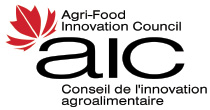AIC in the News: Canadian farmers slow to warm to AI, automation
November 8, 2019
Standing onstage in an ornate conference room at the Delta Bessborough Hotel in downtown Saskatoon, former Saskatchewan premier Dr. Grant Devine pitched the agri-food industry on a new idea: a wheat tube.
More specifically, a hypothetical hyperloop Devine says could fire shipments of wheat from Moose Jaw to Langley, B.C. at hundreds of kilometres an hour. He says students at the University of Saskatchewan, where he is a professor, had priced the idea at around $18 billion.
“You’d load it like you would any other hopper car, load it in the capsule and — zoom! — it’s out there in a matter of hours,” Devine said.
It’s an odd example of how artificial intelligence, robotics and automation transforming agriculture.
This week’s conference organization by the Agri-Food Innovation Council aimed to highlight how tech could address problems like labour shortages on Canadian farms – and address a dissonance between what’s already available and what farmers are using.
“It’s not a question of when AI is coming. AI is already here,” Agri-Food Innovation Council CEO Serge Buy said. “The new technologies are coming much faster than anticipated. The problem now is how we enable producers to adopt those technologies.”
Canada is generally recognized as a world leader in AI innovation, propelled by hundreds of millions in federal funding for “superclusters” of research. One supercluster aims to make Western Canada a leader in producing non-animal protein, for example.
And while the traditional image of agriculture might clash with images of robots and the next generation of tech, AI is already being used to sort seeds; deploy pesticides; spread fertilizer and even harvest crops.
Dawn Trautman, is the manager of smart agriculture and food innovation with Alberta Innovates, one of the groups that received a $49.5 million grant from the federal government to expand automation and digitization of farming.
She calls it “the next revolution for agriculture.”
“Governments in general are very interested in the potential of digital technologies in multiple industries. There’s a big potential to fill that gap of all the data that might be available for producers, like sensors in the soil or cloud computing,” Trautman said.
But while much of the technology is already here, farmers have been slow to adopt it.
Buy says part of the issue are thin margins for farmers, whose bottom lines are already being shrunk by bad harvest weather and trade spats.
Professor Sylvain Charlebois, director of the Agri-Food analytics lab at Dalhousie University, says the most serious problem is a lack of applicable data from agriculture and a risk-adverse industry. He points out much of the investment in new technology is not coming from the agriculture sector but rather telecom companies like Telus.
“Let me put it this way: It’s like we’re building a house, and we have a beautiful new shiny room, but we don’t have any walls,” Charlebois said.
Charlebois says the dearth of data in Canada is so bad that metrics from the United States are actually better for predicting market behaviour.
Without that data, AI can’t be used to its full potential.
Buy agrees the industry has been slow to adapt, though he’s more optimistic.
“I think everyone is astounded at the speed this is going,” Now everyone’s saying ‘Oh jeez, how do we catch up?’”
